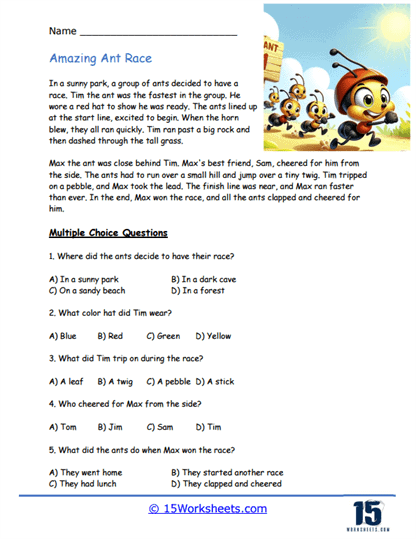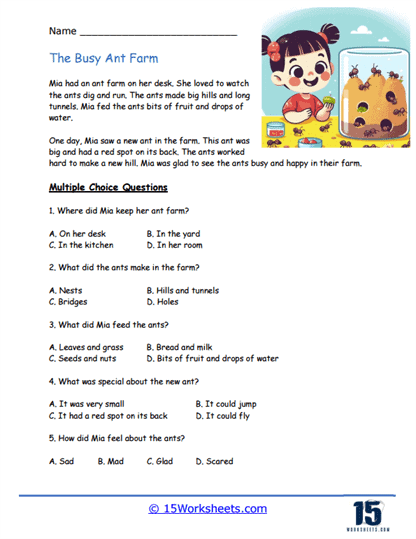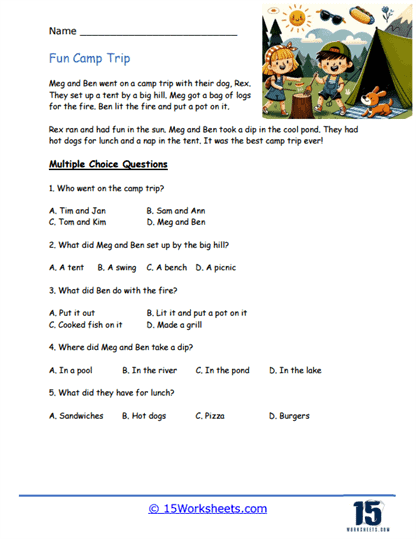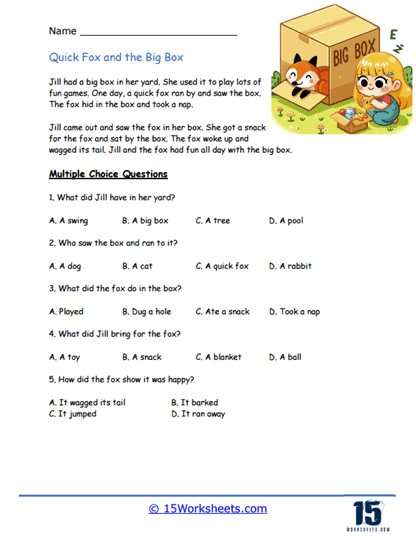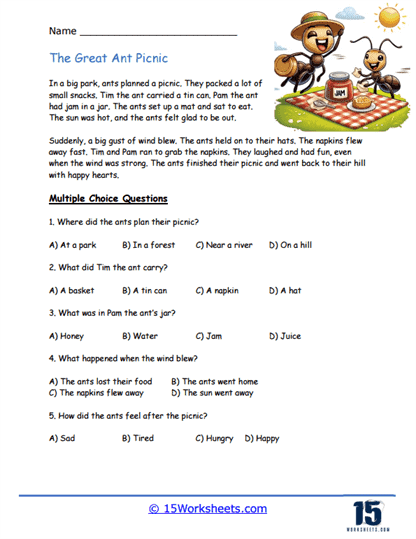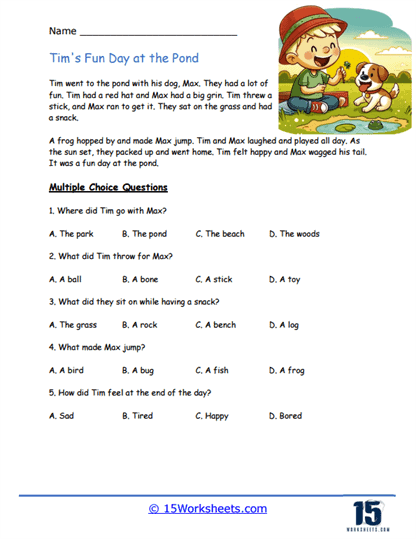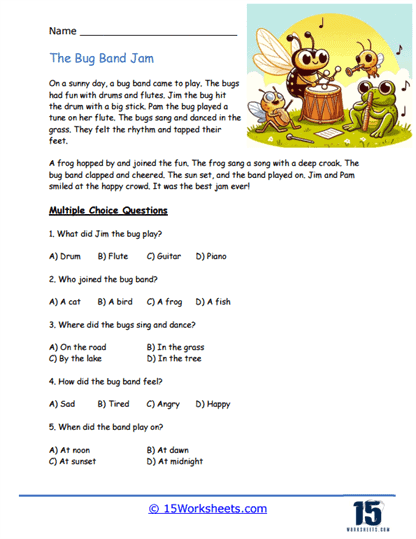Short Vowel Reading Passages Worksheets
About These 15 Worksheets
Short Vowel Reading Passages with questions worksheets are a versatile and effective tool for developing early reading skills. They combine engaging, simple texts with targeted questions that reinforce phonics, comprehension, and fluency. By regularly practicing with these worksheets, students can build a strong foundation in phonics, gain confidence in their reading abilities, and develop a deeper understanding of the reading process. Ultimately, these skills contribute to making students better, more proficient readers who are prepared for the challenges of more complex texts as they progress in their education.
These types of worksheets are designed to help young readers develop foundational phonics skills by focusing on short vowel sounds. These worksheets are structured to provide students with engaging reading passages that predominantly feature words containing short vowel sounds, followed by a series of comprehension and phonics questions to reinforce learning and assess understanding. Short vowels, which are typically the sounds made by the letters ‘a,’ ‘e,’ ‘i,’ ‘o,’ and ‘u’ when they are not followed by a consonant in the same syllable, are crucial for early literacy development.
These worksheets normally begin with a reading passage that emphasizes short vowel sounds. These passages are crafted to be engaging and suitable for the students’ reading levels, often involving simple narratives or descriptions. For example, a passage might tell a story about a cat that sits on a mat and meets a rat, incorporating numerous short ‘a’ vowel sounds. Another passage might describe a pig in a wig that sits in a big rig, emphasizing the short ‘i’ sound. By embedding short vowel sounds in context, students can see how these sounds are used in everyday language, making the learning experience more meaningful and enjoyable.
Following the passage, the worksheet typically includes a variety of questions designed to assess both comprehension and phonics skills. Comprehension questions ensure that students understand the content of what they have read. These questions might ask students to recall specific details from the passage, such as “Where does the cat sit?” or “What is the pig wearing?” Such questions help reinforce the students’ ability to remember and recount details from the text, which is a fundamental aspect of reading comprehension.
Phonics-focused questions are aimed at reinforcing the recognition and use of short vowel sounds. For instance, students might be asked to identify words with short vowel sounds from the passage, circle the correct short vowel sound in a list of words, or match words with pictures. A common exercise might present several words from the passage and ask the student to underline all the words with a short ‘e’ sound, like “bed,” “red,” and “pet.” Another exercise might provide partial words with a missing vowel, such as “_at,” and ask the student to fill in the correct short vowel to form a word, like “cat” or “bat.” These activities help students practice recognizing and using short vowel sounds in various contexts, reinforcing their phonemic awareness and sound-letter correspondence skills.
Some worksheets also include activities that require students to sort words based on their vowel sounds. For example, students might be given a list of words and asked to sort them into columns based on whether they contain the short ‘a,’ ‘e,’ ‘i,’ ‘o,’ or ‘u’ sound. This type of sorting exercise reinforces the students’ ability to distinguish between different vowel sounds and understand the systematic nature of phonics, where similar patterns can be identified and applied to new words.
Visual aids are often incorporated into these worksheets to support learning. Pictures that correspond to the words in the passage can help students make connections between the words and their meanings. For example, a picture of a cat sitting on a mat next to the word “cat” helps students visually associate the word with the object, reinforcing their understanding of the word’s meaning and pronunciation.
Practicing with Short Vowel Reading Passages with questions worksheets offers numerous benefits for students’ phonics development and overall reading proficiency. Regular exposure to short vowel sounds helps students become more familiar with these basic phonetic patterns, which are essential for decoding simple words. By encountering these vowel patterns in different contexts, students develop a stronger grasp of how they sound and how they are used in words.
Phonemic awareness is another critical skill that these worksheets help to develop. Phonemic awareness is the ability to hear, identify, and manipulate individual sounds in words, which is essential for reading and spelling. By focusing on short vowel sounds, students practice distinguishing between different vowel sounds and understanding how these sounds blend together to form words. This awareness is crucial for decoding new words and improving spelling accuracy.
These worksheets also contribute to improved reading fluency. Fluency involves reading with speed, accuracy, and proper expression. As students become more comfortable with short vowel sounds, they can read passages containing these sounds more smoothly and accurately. This fluency allows them to focus more on understanding the text rather than decoding each word, leading to better overall comprehension.
Comprehension skills are directly targeted through the questions that follow the reading passages. By answering questions about the text, students practice recalling information, making inferences, and understanding the main ideas and details of what they have read. These skills are essential for academic success across all subjects, as they enable students to understand and engage with complex texts as they progress through their education.
Practicing with Short Vowel Reading Passages with questions worksheets helps students develop a love for reading. The engaging and accessible nature of the passages can spark a child’s interest in stories and books. When children find reading enjoyable and rewarding, they are more likely to read independently, further reinforcing their skills and fostering a lifelong habit of reading.
In the classroom, teachers can use these worksheets as part of a structured literacy program or as supplementary material to support individual student needs. They provide a concrete way to track a student’s progress in phonics and reading comprehension. Teachers can use the results of these worksheets to identify areas where a student may need additional support or targeted instruction. For example, if a student consistently struggles with recognizing short vowel sounds, the teacher can provide additional practice and instruction in that area.
Parents can also use these worksheets at home to support their child’s reading development. The simplicity and clarity of Short Vowel Reading Passages make them ideal for home practice, where parents can work one-on-one with their child to reinforce skills learned in school. This home-school connection can be particularly beneficial, as it provides children with consistent and reinforced practice, helping them make steady progress in their reading abilities.







